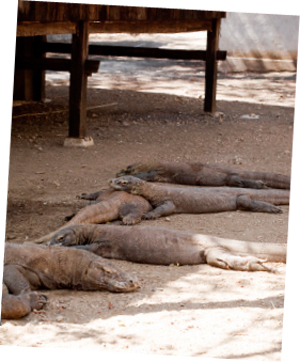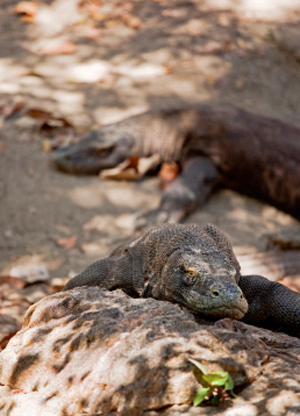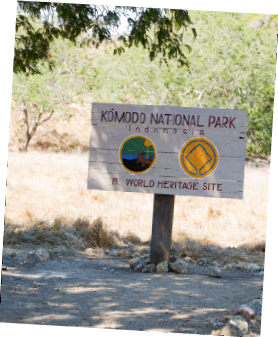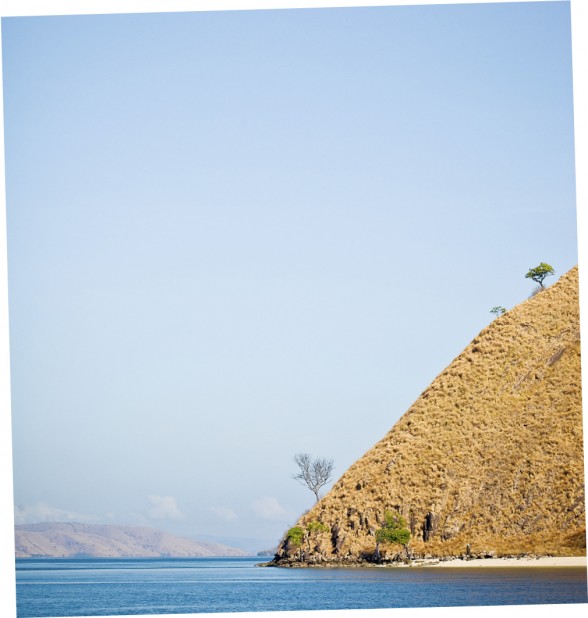Respect the Beasts
On a somewhat stylish visit to Indonesia’s Komodo National Park, Adam Skolnick comes face to face with dragons and lives to tell the tale.
Travel+Leisure Southeast Asia Magazine – January 2010.
On a sweltering morning Condo Subagyo, 46, and I hack through thick brush to reach a red clay trail. We follow it as it winds beneath huge tamarind trees dangling with python-thick vines that disappear into undergrowth of wild basil. Streams trickle through the forest harmonizing with a chorus of crickets, cycads, frogs and cockatoos. The air is heavy and moist. Sweat trickles down Condo’s hairless dome as the worn trail rises onto a plateau blanketed in knee-high savannah.
Pulau Komodo, the larger of the two main islands that make up Komodo National Park—the other being Rinca—isn’t always this lush. Most of the year it’s sun-dried to an almost crisp golden brown. Now, during the December–March wet season, it’s as green as Switzerland.
It’s then we hear a distinct, low, disconcerting grunt. Condo freezes. “You hear that?” he asks with a gleam in his eye. “We found one!” His focus narrows and becomes fixed on a lump in the grass not 7 meters away. I see it for the first time: the world’s largest lizard, a distant relative of the dinosaurs, the mythic Komodo dragon.
In seconds I start snapping photos like a wonder-drunk neophyte. The creature is a magnificent 3 meters long and, according to Condo, weighs close to 70 kilograms, a relatively large male. His bumpy back is stained red from the cool earth, his muscular tail ridged with razor sharp scales and his long yellow tongue forked at the tip. His eyes burn into us as he leans forward. Then his tongue recoils, he relaxes back into his grass bed and seems to smile. At which point I turn and ask Condo to take my photograph with the dragon over my left shoulder. As he snaps the picture, the dragon huffs again with an exhalation so powerful I jump. And I remember that these lizards can run close to 20 kilometers per hour, about twice as fast as I can on a good day. I turn slowly, sheepishly and glimpse that primordial smile once more. Note to self: respect the beasts.
When making the misguided decision to turn your back on a wild dragon, it’s best to have Condo at your side. The late Steve Irwin knew that when he came to Komodo in 1999 to film an episode of the Crocodile Hunter. One memorable scene was shot on the top of a mountain. Fourteen dragons huddled around goat and buffalo carcasses, tearing bloody flesh with their powerful jaws. “Steve got down on his hands and knees, shoulder to shoulder with the dragons,” Condo recalls as we continue our hike.
“He was growling and pretending to eat alongside them.” Condo stops and considers his brush with fame, and says, “I think he was crazy, but a very nice guy.”
I emerged from the sweaty purgatory that is the baggage-claim area at Labuanbajo airport, the day before, and was swallowed by a swirl of touts eager to charter cars or motorbike taxis and book tours to nearby Komodo National Park. At the edge of it all was the pudgy, ever-smiling Condo, who, though we’d never met, I recognized instinctively.
“We have two boats,” he explained as we drive down the serpentine road that leads from the airport to Labuanbajo’s stunning bay harbor. “Our brand new luxury yacht is 40 meters long. It has hot showers, air-con, two sun decks and a plasma television. It’s very nice.”
“Nothing wrong with luxury,” I thought as I imagined sprawling out in the sun sipping gin and tonics and nodding to the dragons as we steam by.
“But we won’t use that one,” Condo continued. “We will take my other boat, which is still very good. It used to belong to Aman resorts.”
Sure. Fine. No problem. Although Indonesia has long been my favorite destination and Bali has been my second home since 2004, I’d never visited the epic Komodo National Park. I hadn’t glimpsed the dragons. I hadn’t dropped into the world-renowned coral reefs. I was ready for an adventure. Besides if the worst I can do was an old Aman cruiser, I figured comfort wouldn’t be an issue.
Then I saw the boat. Think convalescent cargo hauler. Its wood flanks were somewhere between chipped and disintegrating, the windows in the captain’s cabin were cracked, the oily deck was narrow, stuffed with supplies and dive gear, and crawling with various representatives of the insect kingdom. It may have once been a crew boat for Aman resorts, but that was a lifetime ago. I was about as impressed as Luke Skywalker when he first boarded the Millenium Falcon, which was soon my pet name for our vessel. But once we cruised out to sea, where the hulking frames of Rinca and Komodo dominated the horizon, nature began to work on me. The Falcon carved water smoothly. The breeze cooled me out. I was ready for the journey.
Besides, I wasn’t going to complain about the lack of creature comforts to Condo. The son of a colonel in Suharto’s special forces, he left Purwakarta, his tiny central Java hometown, penniless and on foot, when he was 19. For six months he walked, hitched, squatted and sailed all the way to Flores where he got a job as a ranger in Komodo National Park in 1982. Then, as now, the young, jagged islands were empty, save two stilted fishing villages home to less than 1,000 people. The steep, layered mountains, forests and mangroves have always been the domain of birds, deer, wild boar, buffalo and about 3,000 Komodo dragons.
At first, Condo cooked meals, cleaned cabins and guided tourists along park trails on both Komodo and Rinca. In the early days of Komodo tourism, rangers often fed goat carcasses to dragons so tourists could glimpse them. Condo was the man who delivered the meat. Not an enviable job when you consider that the dragon’s saliva is spiced with septic bacteria. Even a superficial bite can lead to a fatal infection. Which is why it was off-putting to see fresh bloodstains on the walls and windows of Rinca’s national park office in Loh Buaya, a small ranger camp where a dozen dragons come to sniff and scarf kitchen scraps daily.
 “The attack happened a few days ago,” said Abdul Kadir, 25, the ranger who was “protecting” us from the dragons with nothing but a long forked staff. “He was doing paperwork in his office, and the animal went for his legs under the desk.”
“The attack happened a few days ago,” said Abdul Kadir, 25, the ranger who was “protecting” us from the dragons with nothing but a long forked staff. “He was doing paperwork in his office, and the animal went for his legs under the desk.”
Gashed and bleeding, the ranger scrambled to the top of a bookcase and screamed for help, which eventually arrived. “He’s still in the hospital, but he will probably survive,” Kadir told me.
But even with fresh evidence of mortal danger, watching dragons eat leftovers wasn’t what I had in mind, so Condo and I re-boarded the Millennium Falcon and sailed on to Komodo.
As we drew close, Komodo’s eastern peninsula spread out like so many fingers, fringed with a succession of pink sand beaches thanks to an abundance of red coral. The mountains rose jagged, sheltering wooded canyons where female dragons nest and lay their eggs in thick mud banks. But Condo’s attention was fixed on the glassy sea, and a rapidly growing pod of dolphins that begin leaping, breaching, drafting and playing just off our bow.
Always an avid snorkeler, Condo left the park service in 1987 and began exploring these tempestuous waters. The convergence of the warmer Flores Sea and the cooler Selat Sumba (Sumba Strait) translates into strong currents and cold up-swellings, which creates a rich plankton soup that feeds an astonishing diversity of marine life. Mantas and whales, including blue whales, are drawn here to feed during their annual migration from the Indian Ocean to the South China Sea, while dolphins and schools of sharks are also common.
By 1994 Condo was working as a dive instructor, a marine biologist with the Nature Conservancy (he monitored fish and coral populations around Komodo), and a local fixer for Discovery Channel shoots in the national park. In 1996 he opened CN Dive, the second oldest and still the only Indonesian-owned dive shop in Labuanbajo. “I think I discovered over half the dive sites charted in Komodo,” he says. “But I’ve actually dove over 300 sites. Some we never charted because we didn’t want to expose them.”
After communing with the dolphins for the better part of an hour, Condo and I dropped into the reef just off Pantai Mereh, or Red Beach. We soared with the light current over vibrant red coral reefs teeming with thousands of fish, 30 meters beneath the surface. When we surfaced at sunset the sky bled from blue to gold to pink, and thousands of enormous, screeching fruit bats (a.k.a. flying foxes) emerged from the mangroves and took off into the darkening sky.
At sunrise the next morning we were underwater again. This time we dropped into Batu Bolong, a pinnacle crusted in Technicolor coral. Here was my Willy Wonka moment. There are cartoonish sea fans and sad fish faces, a blue-eyed octopus, a slithering sea snake, a giant hawksbill turtle and five reef sharks. Two hours later we swam with a school of grey and white-tip reef sharks at Taka Toko, or Castle Rock. The current was so strong we had to cling to the reef while watching two massive grey sharks and a dozen white tips feed on clouds of tropical fish.
Yes, the diving was spectacular—and it became even more so when I slipped into a manta soup and glided alongside 10 magnificent manta rays later that afternoon—but I still hadn’t seen a dragon in the wild. Which is how we came to be hiking through a remote corner of Pulau Komodo.
We’ve spotted three wild dragons and the remains of a dragon nest by the time we reach a small white cross sprouting from a rock pile on a grassy hilltop. “We call this place Bukit Rudolph,” says Condo. “It’s a memorial to Rudolph Von Reding, a 79-year-old who disappeared on Komodo in 1974.”
That’s nearly 10 years prior to Condo’s arrival as a scrawny 20-year-old, long before Komodo National Park was on the tourist radar and serviced by daily flights from Bali. In the valley below, orioles and cockatoos flit about the forest canopy, which bleeds into a black-water estuary and filters through thick mangroves to the endless blue sea. We can just make out the silhouettes of two buffalo half-submerged in a tidal lagoon as the sun burns. Somewhere, Rudolph is smiling.
Condo certainly is. After soaking it all in, he turns to me, wipes his brow and says, “Now you know why I love Komodo.”
Photos by Lauryn Ishak.



